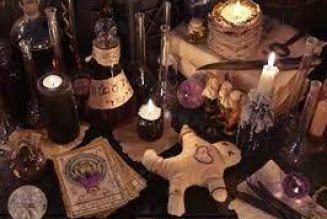A tho is the name given to a carved head of the horned god of witchcraft,
owned by Mr. Raymond Howard of Norfolk. In 1930, when Mr. Howard was a boy, he lived with relations on a farm in Norfolk. Here he
met an old lady called Alicia Franch, who lived with the Gypsies or
Romanys. She took an interest in the boy, whom she first met when he
was playing by a roadside pond on the day of the summer solstice.
Old Alicia apparently took this meeting as a sign, and she taught him
some of the traditions of witchcraft that she knew. She told him that
when she died she would leave him a legacy ; and she kept her word. In
due course, Mr. Howard inherited from Alicia Franch a number of
magical objects, among which was the head of Atho.
I have met Mr. Howard and seen this carved head myself. It is a very
impressive carving, having a crude strength and power which make it a
remarkable work of primitive art. It is fashioned from a solid trunk of
dark oak, evidently very old. The head is adorned with two bulls’ horns,
and inset in various places with silver and jewels. It is covered with
mystic symbols, representing the beliefs of the followers of Atho.
Mr. Howard allowed the head to be photographed by the press, and
shown on television. He now feels this was unwise, as in April 1 967 the
head was stolen from Mr. Howard’s antique shop in Norfolk. Despite
police enquiries, the mystery of the theft remains unsolved. The thief
evidently came specially for the statue, as other valuables and a cashbox containing money were ignored. We can only hope that this remarkable relic of the witch religion will one day come to light again and be
restored to its rightful owner.
It was characteristic of pagan Celtic Britain to carve sacred heads of
deities. These were usually of stone, whereas the head of A tho is of oak.
Nevertheless, the idea may have survived and been handed down. With
widening archaeological discoveries, we know today that the worship
of the Celtic horned god Cernunnos was widespread throughout
Ancient Britain ; many representations of him have been found. The
name Cernunnos is really a title, and means ‘The Horned One’. He was
one of the many versions of the horned god of the witches.
My own painting of the head of A tho is reproduced as an illustration
to this book. It is as precise a copy of the details of the original as the
limits of my talent will allow.
The horns are ornamented with the signs of the zodiac. On the forehead are the five rings of witchcraft, the five different circles which are
cast by witches. The nose is a wine-cup, which holds the Sabbat wine ;
it is ornamented with a pentagram, the sign of magic. The mouth is
shaped like a bird, the messenger of air. The chin is a triangle, with the
various magical meanings of the Triad.
Below are the twin serpents, representing positive and negative forces.
The other symbols depicted around the head are actually carved upon
the original. The sprouting and twining foliage of the background represents the forces of life and fertility, which Atho personifies.
The name Atho is evidently a Sassenach version of the Old Welsh
Arddhu, ‘The Dark One’
